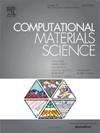Machine learning-accelerated molecular dynamics calculations for investigating the thermal modulation by ferroelectric domain wall in KTN single crystals
IF 3.1
3区 材料科学
Q2 MATERIALS SCIENCE, MULTIDISCIPLINARY
引用次数: 0
Abstract
Ferroelectric perovskite materials, containing ferroelectric domain configurations, are promising thermal switching candidates in thermal management due to their fast response and efficient heat flow control. However, most of ferroelectric materials possess fixed or narrow Curie temperature range. In present study, the thermal-switching characteristics of ferroelectric potassium tantalate niobate (KTN) crystals, in which the Curie temperature can be adjusted by Ta/Nb ratio, are investigated by Machine Learning-Accelerated Molecular Dynamics calculations. Results show that temperature is an effective way to modulate thermal transport behavior. For 180°- and 90° DW, maximum thermal switching ratio are obtained at 300 K, with 1.80 and 1.89, respectively. Further modulation of thermal by the density of DWs strengthen the thermal switching effect. After introducing nine DWs in our calculation model, thermal switch ratio can be modulated to 2.19 and 2.29 for 180°- and 90° DWs configurations, respectively. Phonon anharmonicity investigation demonstrates that the decrease of phonon relaxation time of low frequency phonons (0–15 THz) are responsible for the difference of thermal conductivity between mono- and multidomain walls configuration. Large thermal switching ratio and flexible regulation of Curie temperature provide ferroelectric KTN crystal a broad application prospect in the field of intelligent thermal management.

求助全文
约1分钟内获得全文
求助全文
来源期刊

Computational Materials Science
工程技术-材料科学:综合
CiteScore
6.50
自引率
6.10%
发文量
665
审稿时长
26 days
期刊介绍:
The goal of Computational Materials Science is to report on results that provide new or unique insights into, or significantly expand our understanding of, the properties of materials or phenomena associated with their design, synthesis, processing, characterization, and utilization. To be relevant to the journal, the results should be applied or applicable to specific material systems that are discussed within the submission.
 求助内容:
求助内容: 应助结果提醒方式:
应助结果提醒方式:


